
General research mission and vision
As a landscape ecologist interested in wildlife conservation, it is my mission to help mitigate the negative effects of increasing anthropogenic impacts on biodiversity. My scientific vision is to 1) increase our understanding of how anthropogenic impacts affect the ecological processes that determine the distribution of wildlife at landscape scales, and 2) to use this increased understanding to enhance the effectiveness of wildlife conservation. I combine modelling techniques with fieldwork to get a better understanding of how species are faring, now and in the future. My main focus is on mammals and birds in cold-climate regions and boreal forest ecosystems.
Short research background
Although I have a background in tropical ecology and nature conservation through a degree at Wageningen University, I slowly moved to colder regions. I conducted my Bachelor thesis in Botswana at the Harry Oppenheimer Okavango research centre, studying the effects of the mineral quality and quantity of the grassland vegetation on the diversity of large herbivores in the Okavango Delta. In El Salvador I studied the diet and habitat selection of the stingless bee Mellipona beecheii, working together with Utrecht University and the Ministry of Agriculture of El Salvador.
But after this tropical start I moved north to conduct a study on the influence of heavy metals in the soil on the territory size and food availability of the black-tailed godwit in The Netherlands at Alterra research Centre. I further worked as a research assistant for A Rocha Portugal, an organisation for nature conservation. Here I focused my work more and more on birds, working on waders and owls and starting to train to become a bird ringer.
Moving north again, I obtained my phd in mammal ecology from Royal Holloway, University of London, where I studied hedgehogs. The main aim of this project was to better understand the extent of, and the mechanisms behind, the apparent decline of the hedgehog throughout Great Britain since 1960. Using a variety of modelling techniques, public participation surveys, questionnaires and a lot of fieldwork I found that although hedgehogs are still widely distributed, their numbers have been falling considerably. This was mainly correlated with an increase in badger abundance, loss of suitable habitat and increased habitat fragmentation.
After obtaining my doctorate I moved to the subarctic zone, where I got a position as postdoctoral researcher at the Landscape Ecology group in the Department for Ecology and Environmental Science from Umeå University in Sweden. The overarching aim of my work there was to assess how climate change may affect the geographic distribution of species and the effectiveness of the current protected area network in subarctic and arctic Europe. This study included approximately 500 species of amphibians, butterflies, birds, mammals, moths, plants, slugs, snails, and reptiles and a number of detailed studies on species like the arctic fox and the spotted nutcracker.
I then held a position at the Department of Wildlife, Fish and Environmental Studies at the Swedish University for Agricultural Sciences (SLU). As part of the forest Biocore group, I worked within the interdisciplinary RESTORE project and focused on the impact of boreal forest restoration on threatened species, like the white-backed woodpecker, in the context of future climate change. I further worked on a project that aimed to assess the (future) vulnerability of the black guillemot in the Baltic Sea region, in collaboration with Umedelta's birdbanding station. This project was funded by the King Carl XVI Gustafs 50-year fund for science, technology and environment.
I then conducted a postdoctoral position in the Forest Ecosystem and Landscape Ecology lab of the Department of Forest and Wildlife Ecology of the University of Wisconsin-Madison in the USA. Here I assessed the impact of different forest management options to reduce climate change impacts on ecosystem services in a forest in British Columbia, Canada.
Current work
In 2017 I started an assistant professorship in the Wildlife Ecology and Conservation Group at Wageningen University where I focus my research again on landscape and wildlife ecology. I am also still affiliated with the Department of Wildlife, Fish and Environmental Studies at the Swedish University for Agricultural Sciences where I continue my work on forest and climate change ecology. I also lead an ongoing project aimed at the conservation of the locally endangered black guillemot population in the Baltic Sea region in collaboration with The Ume River Delta Field Station and others. You can read all about this project on the following website http://project-black-guillemot.weebly.com/

